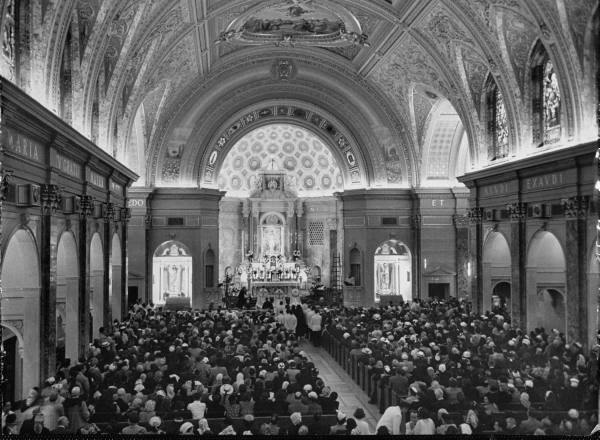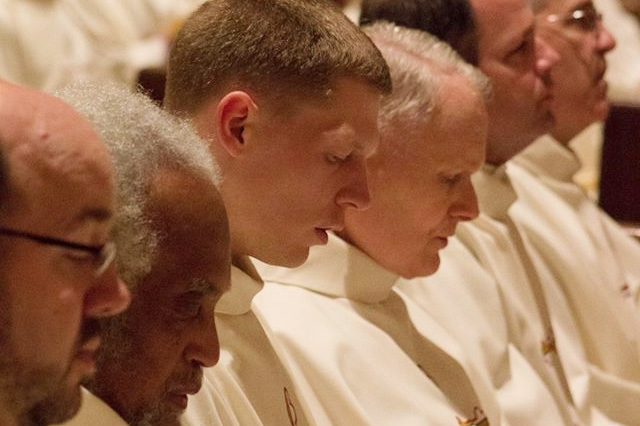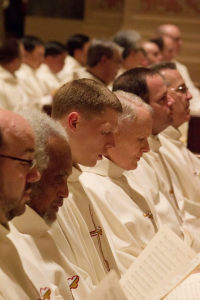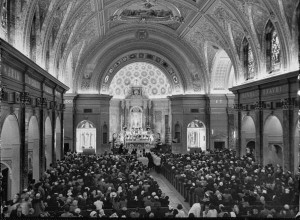 The great influx of Catholic immigrants from Europe brought exponential growth to the Catholic population of this country, making Catholicism the single largest religious group by far. Those Catholic immigrants gathered together in ethnic parishes, creating ethnic neighborhoods in which faith and culture were knitted together. They sought survival in a land that seemed at times to be hostile to them and their faith. This caused Catholics to be fiercely loyal to the faith and made the parish the hub of the community, the center around which all else revolved.
The great influx of Catholic immigrants from Europe brought exponential growth to the Catholic population of this country, making Catholicism the single largest religious group by far. Those Catholic immigrants gathered together in ethnic parishes, creating ethnic neighborhoods in which faith and culture were knitted together. They sought survival in a land that seemed at times to be hostile to them and their faith. This caused Catholics to be fiercely loyal to the faith and made the parish the hub of the community, the center around which all else revolved.
Alas, this vivid reality receded between the 1950s and the 1980s, leaving large structures behind that have proved difficult to maintain and are now being closed in large numbers. Sweeping social changes, a cultural revolution, and the slow assimilation of Catholics into the wider American culture led to the demise of a system that is hard not to admire for its organization and effectiveness.
How things collapsed so quickly is a matter for some speculation, but even within the genius of the ethnic Catholic system, there were the seeds of its own destruction, for the fierce clinging of Catholics to their faith was as much due to ethnic bonds as it was to the religion itself.
As we shall see in the description below, and as most bishops can attest, shepherding Catholics is much like herding cats. This struggle is not a new one. It was well on display even in the glory years. Despite the outward appearances of deep unity, there were many fissures just beneath the surface.
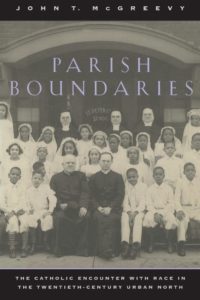 As a brief study of this, I would like to quote somewhat extensively from the first chapter of a book by John McGreevy: Parish Boundaries: The Catholic Encounter with Race in the 20th Century Urban North. McGreevy rather vividly describes the strength of the immigrant Church but also the more negative trends within that powerful system of ethnic Catholicism.
As a brief study of this, I would like to quote somewhat extensively from the first chapter of a book by John McGreevy: Parish Boundaries: The Catholic Encounter with Race in the 20th Century Urban North. McGreevy rather vividly describes the strength of the immigrant Church but also the more negative trends within that powerful system of ethnic Catholicism.
The author’s work is presented in bold, black italics, while my remarks are in plain red text. I have reworked the order of some of his reflections and am presenting excerpts from a much longer chapter. I hope you’ll find his description of the urban ethnic Church as thrilling and vivid as I do.
[From the late 1800s through the middle part of the 20th century] successive waves of European immigrants peopled a massive and impressive church largely in the northern cities of America. In 1920, Catholics in Chicago could worship at 228 Catholic parishes … The [area of the city called] “back of the yards” area physically exemplified this. There, residents could choose between 11 Catholic churches in the space of little more than a square mile: two Polish, one Lithuanian, one Italian, two German, one Slovak, one Croatian, two Irish, and one Bohemian. … Their church buildings soared over the frame houses and muddy streets of the impoverished neighborhood in a triumphant display of architectural and theological certitude. I have always appreciated that older Church buildings reflect a time of greater theological certitude. While one may criticize the presence of opulent church structures in poor neighborhoods, the immigrants built them eagerly, demonstrating a priority of the faith that is much less evident today.
[Even as late as the] 1950s, a Detroit study found 70% of the city’s Catholics claiming to attend services once a week as opposed to only 33% of the city’s white Protestants and 12% of the city’s Jews. Catholics really used to pack the churches. I remember as a youth if you were late for Mass you had to stand in the back.
The Catholic parishes, whether they were Polish, Italian, Portuguese, or Irish, simply dominated the life and activities of the community with quite popular and well attended programs. Yale sociologists investigating in the 1930s, professed amazement at the ability of priest to define norms of everyday social behavior for the church’s members.
The Catholic world supervised by these priests was disciplined and local. Many parishes sponsored enormous neighborhood carnivals each year. Most parishes also contained a large number of formal organizations including youth groups, mothers’ clubs, parish choirs, and fraternal organizations—each with a priest moderator, the requisite fundraisers, and group masses. Parish sports teams, even for the youngest boys, shaped parish identity, with fierce (and to outsiders incongruent) rivalries developing in sports leagues between parishes. CYO rivalries were legendary even into the 1980s in many areas.
These dense social networks centered themselves around an institutional structure of enormous magnitude. Virtually every parish in the northern cities included a church (often of remarkable scale), a convent, a parochial school, a rectory, and occasionally, ancillary gymnasiums or auditoriums. Even hostile observers professed admiration for the marvelous organization and discipline of the Roman Catholic Church, which carefully provided every precinct, ward, and district with churches, cathedrals, and priests. The parish I attended as a boy in Glenview, IL (North Chicago) had a rectory that was externally a replica of Mt. Vernon. The parish plant took up an entire city block. Every grade of the parochial school had its own separate building. There was an indoor pool, a credit union, a large indoor “playdium” that allowed for everything from roller-skating to basketball. The Church and convent were also magnificent.
Brooklyn alone contained 129 parishes and over 100 Elementary schools. In New York City more generally, 45 orders of religious men, ranging from the Jesuits to the Passionist Fathers, lived in community homes. Nuns managed 25 hospitals. The clergy and members of religious orders supervised over 100 high schools, as well as elementary schools that enrolled 214,000 students. The list of summer camps, colleges and universities, retreat centers, retirement homes, seminaries, and orphanages was daunting.
St. Sabina in Chicago was a typical example of an immigrant parish. The parish was founded in 1916 upon request by Irish-Americans. The male members of the 7000-member parish were mostly policemen, streetcar operators, lower management persons, and teachers. Within the tenure of the very first pastor, the parish erected a church costing $600,000 and contracted the work to members of the parish to provide jobs during the depression. They built the school, convent, and rectory as well as founding a staggering array of athletic, religious, and social organizations. By 1937 the Parish plant also included a community center with a full basketball court that seated 1800 people. Attendance at roller-skating shows often climbed to over 10,000. Parishioners packed the church and hall for 11 separate Sunday masses, and ushers organized large crowds at multiple Friday evening novena services. $600,000 in the 1930s was an enormous sum of money, equivalent to nearly 9 million in 2013 dollars. I am presuming that the $600,000 was for the whole plant, not just the Church.
[The Catholic system of neighborhood-based parishes had little equivalence among the Protestants.] When examining the splendidly organized system constructed by Roman Catholics, Protestant analysts bemoaned the parochial chaos in the fragmentation of membership which the Protestant groups had experienced. The general Protestant lack of geographical parishes made it impossible to know who should be responsible, or to hold anyone responsible for the church and of any given area. Synagogues faced similar dilemmas. Most synagogues drew members from a broad area, and competed with neighboring synagogues in terms of ritual and programs.
[In the immigrant years, the Catholic parish made, cemented, and ruled over a local neighborhood]. An observer noted how the church building occupied an entire block, adding that the building’s resounding bells, with its immense throngs of worshipers, with its great tower so built that illumined, it reveals by night the outlines of the cross help define the area. Put another way, the neighborhoods were created not found. For the parishioners, the neighborhood was all Catholic, given the cultural ghetto constructed by the parish. Yes, the Church was the true hub of the community.
Catholics enacted this religiously informed neighborhood identity through both ritual and physical presence. A powerful indicator of the importance of the Catholic parish was found in the answer of Catholics (and some non-Catholics) to the question “where you from?” Throughout the urban North, American Catholics answered the question with parish names—Visitation, Resurrection, St. Lucy’s, etc. All of this meant that Catholics were significantly more likely to remain in a particular neighborhood than the non-Catholics. [And Catholic neighborhoods resisted strong demographic shifts and swings much longer than other urban neighborhoods.] Naming the neighborhood for the parish was common in Chicago.
For American Catholics, neighborhood, parish, and religion were constantly intertwined. Catholic parishes routinely sponsored parades and processions through the streets of the parish, claiming both the parish and its inhabitants as sacred ground. Catholic leaders also deliberately created a Catholic counterpart for virtually every secular organization. The assumption was that the Catholic faith could not flourish independent of the Catholic milieu; schools, societies, and religious organizations were seen as pieces of a larger cultural project. The instinct that faith and culture must be intertwined is a sound one. It is clear that as Catholic culture waned, so did the faith. More broadly, as a Judeo-Christian culture in the U.S. has waned, so has belief and practice of the faith.
[Catholic life was also far deeper in daily life than most Protestant expressions.] Where both Jews and Protestants emphasized the reading of text, Catholics developed multiple routes to the sacred. Theologians describe this as a “sacramental” imagination, willing to endow seemingly mundane daily events with the possibility of grace. When asked, “Where is God?” Catholic children responded “Everywhere!” God was most visible during the Mass, when the parish community shared Christ’s body and blood. But God was also visible in the saints lining the walls of the church, the shrines dotting the yards of Catholic homes, the statue of Mary carted from house to house, the local businesses shuttering their doors on the afternoon of Good Friday, the cross on the church steeple looming above the neighborhood row houses, the priest blessing individual homes, the nuns watching pupils on the playground while silently reciting the rosary, the religious processions through the streets, and the bells of the church ringing each day over the length of the parish. A magnificent description of sacramental imagination here. It is the genius of Catholicism. Unfortunately, to our peril, we have lost of lot of it. Thankfully, though, we have recovered some of it in recent years.
McGreevy then goes on to describe some of the fissures that would later come home to roost. One of these was a fierce independence and near refusal to live within the wider Church:
Each parish was a small planet whirling through its orbit, oblivious to the rest of the ecclesiastical solar system. … All parishes, formerly territorial or not, tend to attract parishioners of the same national background. The very presence of the church and school buildings encouraged parishioners to purchase homes nearby helping to create Polish, Bohemian, Irish, and Lithuanian enclaves within the larger neighborhood.
[But] The situation hardly fostered neighborhood unity. Observers noted that various clergy had nothing but scorn for their fellow priests. Pastors were notorious for refusing to cooperate with (or even visit) neighboring parishes. A Washington Post reporter agreed, “the Lithuanians favored the Poles as enemies, the Slovaks are anti-Bohemian. The Germans were suspected by all four nationalities. The Jews were generally abominated, and the Irish called everyone else a foreigner.” It was a kind of extreme parochialism.
Most of the parishes also included parochial schools staffed by an order of nuns of the same ethnicity as the parish in which they served. Eastern European newcomers resolutely maintained their own schools instead of filling vacant slots in nearby Irish or German schools. Even I, born in 1961, remember how Irish and Italian Catholics were barely on speaking terms with one another. In one parish I knew, an Irish girl married an Italian man, causing quite a stir. After their marriage, the couple could not worship in either of their home parishes, but had to find a third.
A 1916 Census survey revealed 2230 Catholic parishes using only a foreign language in their services, while another 2535 alternated between English and the parishioners’ native tongue. Even small towns divided the Catholic population into Irish, Italian, and Portuguese parishes. Detroit’s Bishop Michael Gallagher, himself the son of Irish immigrants, authorized the founding of 32 national parishes out of a total of 98. In 1933, Detroit Catholics could hear the Gospel preached in 22 different languages. It was a kind of Balkanized scene.
Episcopal attempts to quash national parishes, schools, and societies only strengthened national identities. After one conflict with the local bishop and the Polish community, one participant in the revolt noted that such revolts “gave proof that we will not permit anyone to destroy national dignity, pride, and traditions. Another statement from a Polish group warned of ominous consequences if Poles were to be “deprived of the care of a Bishop from among our own race.” Cardinal Medeiros of Boston was never really accepted by that Archdiocese because he was not Irish. His painful tenure there (1970-1983) is detailed by Philp Lawler in his book The Faithful Departed. And this was long after ethnic rivalries had largely abated in the U.S. The fact is, most American bishops knew that they had a huge mess on their hands; beginning in the 1950s, they began to limit the formation of national parishes and even outright closed some that were smaller and more contentious. To this day a few breakaway Polish National Churches still refuse the authority of the local bishop.
Rather than face outright revolt, bishops working with national groups generally assigned an auxiliary bishop or senior cleric to handle pastoral appointments and mediate intramural disputes. Outright revolt was a real possibility. Rebellion against Church authority did not begin in 1968. It had roots going way back. True dissent from Church teaching was rare, but the rebellion against lawful Church authority likely set the stage for later revolt against what that authority taught.
Despite Episcopal concerns … 55 percent of Catholics in Chicago worshiped at national parishes as late as 1936. In addition, over 80 percent of the clergy received assignments in parishes matching their own national background.
Overall the period of ethnic Catholicism is glorious to behold. Such a vibrant and tight knit expression and experience of the faith! But, it would seem, there was also a dark side.
The fierce and proud independence of the ethnic parishes reacted poorly with the rebellion against authority that was coming in American culture. Today, many of the problems that existed then have only grown: the resistance to the authority of the bishop, the insistence on a perfect “designer parish,” and the tendency to tuck the faith behind other loyalties that have taken the place of ethnicity (e.g., politics). These things were certainly simmering in the vibrant ethnic years, and sometimes they weren’t just simmering—they were right out in the open. Yes, shepherding Catholics is like herding cats.
Still, I’m sorry I missed that period of time. At the end of the day, though, we ought to resist overly idealizing any era. Scripture says, Say not, “How is it that former times were better than these?” For it is not in wisdom that you ask this (Eccles 7:10).

